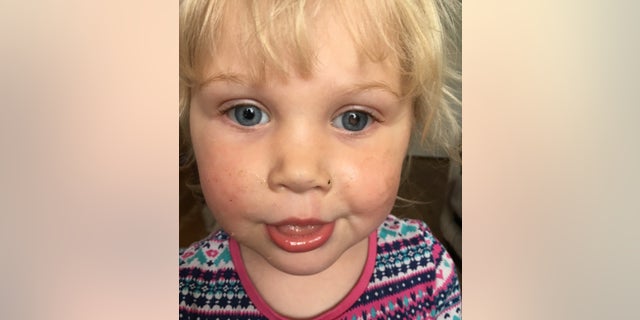
Alice Taylor, 2, was diagnosed with a rare eye cancer shortly after playing a game of pirates with her mom.
(Emily Taylor/Childhood Eye Cancer Trust)
Emily Taylor was playing a game of pirates with her spunky 2-year-old daughter Alice when she realized the toddler was having trouble seeing after putting an eye patch over her right eye.
For months, the mom knew her daughter had been squinting out of her left eye, but there was never any indication she was going blind. She took her to see a general practitioner, an optician and even the eye department at a local hospital in Poole, England, but the only advice she received was that Alice would possibly have to wear a corrective eye patch.
"We didn’t think there was anything urgent to worry about," Taylor recently explained in a blog post for the Childhood Cancer Trust, a London-based charity.
But Taylor knew something wasn't right. So, she decided to take matters into her own hands.
The mom conducted several eye tests at home, including playing a pirate game, to determine how bad her toddler's eye really was. She examined Alice and noticed in certain lighting her eye looked "almost see-through."

Alice Taylor, now 4, is adjusting to her new normal.
(Emily Taylor/Childhood Eye Cancer Trust)
"We played a pirate game, putting a patch over her ‘good eye’ and it became clear that she couldn’t see. At that point I panicked and called the hospital to ask if we could be seen sooner," she said.
CALIFORNIA MOM BITTEN BY 'KISSING BUG' WARNS OTHERS ABOUT DANGER OF 'SILENT KILLER' PARASITIC DISEASE
She was eventually taken to the Royal London Hospital, where she was diagnosed with retinoblastoma — a rare eye cancer that develops in the retina — in May 2017. On average, only about 200 to 300 children are diagnosed with retinoblastoma each year in the U.S., according to the American Cancer Society. In the U.K., it's even rarer: roughly 50 to 60 kids are diagnosed every year, NHS England reports.
“They told us that we could remove Alice’s eye straightaway or try chemotherapy, and there was a 50/50 chance of saving it," Taylor said, adding she opted for chemo to try to give her "normality" as she grew up.
"The doctors told us that it was best for Alice to remove her eye… You get to the point when you just want the nightmare to end."
After at least eight rounds of chemo, cryotherapy and laser therapy, the Taylors determined Alice's condition wasn't improving. In June, they agreed it was best to surgically remove the entire diseased eye.
PENNSYLVANIA WOMAN SAYS CONTACT LENS CAUSED RARE INFECTION THAT LED TO 'STABBING PAIN,' POSSIBLE BLINDNESS
“The doctors told us that it was best for Alice to remove her eye. At that point we’d had enough too, it wasn’t fair to put her through any more. Enucleation was the worst case scenario for me but you get to the point when you just want the nightmare to end. When it happened it was actually very peaceful," Taylor said, noting Alice recovered "quickly" after the operation.
Since then, Alice was fitted for an artificial eye, which she describes as her "special eye." Her family says she's adjusting well.
“Alice has been incredible. She has really taken to her special eye and it doesn’t faze her. I thought it would be really noticeable but it’s not at all, the artificial eye is amazing. Alice still has to have check-ups every three to four months but she can finally get on with her life and enjoy being a typical cheeky, fun-loving little girl," Taylor added.
Source: Read Full Article
